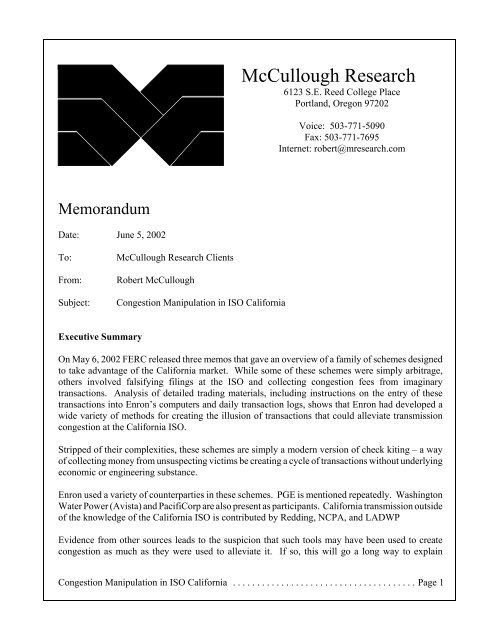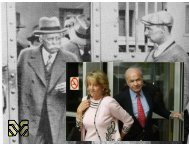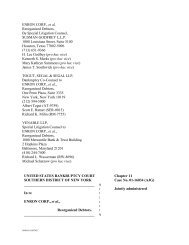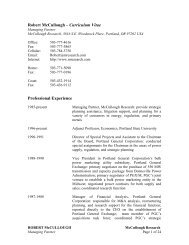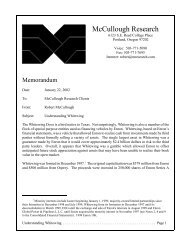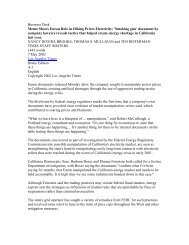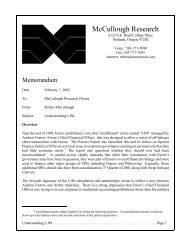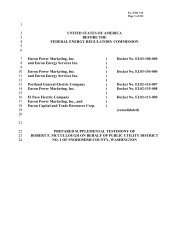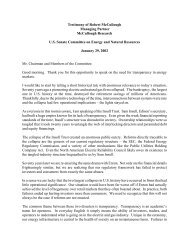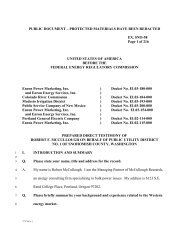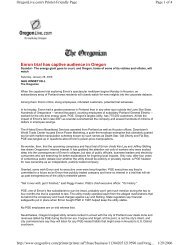Congestion Manipulation - McCullough Research
Congestion Manipulation - McCullough Research
Congestion Manipulation - McCullough Research
You also want an ePaper? Increase the reach of your titles
YUMPU automatically turns print PDFs into web optimized ePapers that Google loves.
<strong>McCullough</strong> <strong>Research</strong><br />
6123 S.E. Reed College Place<br />
Portland, Oregon 97202<br />
Voice: 503-771-5090<br />
Fax: 503-771-7695<br />
Internet: robert@mresearch.com<br />
Memorandum<br />
Date: June 5, 2002<br />
To:<br />
From:<br />
Subject:<br />
<strong>McCullough</strong> <strong>Research</strong> Clients<br />
Robert <strong>McCullough</strong><br />
<strong>Congestion</strong> <strong>Manipulation</strong> in ISO California<br />
Executive Summary<br />
On May 6, 2002 FERC released three memos that gave an overview of a family of schemes designed<br />
to take advantage of the California market. While some of these schemes were simply arbitrage,<br />
others involved falsifying filings at the ISO and collecting congestion fees from imaginary<br />
transactions. Analysis of detailed trading materials, including instructions on the entry of these<br />
transactions into Enron’s computers and daily transaction logs, shows that Enron had developed a<br />
wide variety of methods for creating the illusion of transactions that could alleviate transmission<br />
congestion at the California ISO.<br />
Stripped of their complexities, these schemes are simply a modern version of check kiting – a way<br />
of collecting money from unsuspecting victims be creating a cycle of transactions without underlying<br />
economic or engineering substance.<br />
Enron used a variety of counterparties in these schemes. PGE is mentioned repeatedly. Washington<br />
Water Power (Avista) and PacifiCorp are also present as participants. California transmission outside<br />
of the knowledge of the California ISO is contributed by Redding, NCPA, and LADWP<br />
Evidence from other sources leads to the suspicion that such tools may have been used to create<br />
congestion as much as they were used to alleviate it. If so, this will go a long way to explain<br />
<strong>Congestion</strong> <strong>Manipulation</strong> in ISO California ......................................Page 1
inconsistencies in the data from January 2001 that shows that while the California ISO believed that<br />
it was shipping energy north, the Bonneville Power Administration shows that net energy flows were<br />
going south. The California ISO needs to be encouraged to make transmission schedules, congestion<br />
payments, and actual flows from January 2001 public so that the question whether these schemes may<br />
have caused the blackouts during this period can be investigated.<br />
Table of Contents<br />
Introduction ...................................................................2<br />
Enron’s Continuing Role In Imaginary <strong>Congestion</strong> ....................................3<br />
Deathstar, Black Widow, Big Foot, Cong Catcher, Forney’s Perpetual Loop, and Red Congo . . . 4<br />
Schedules and Flows ............................................................5<br />
Deathstar .....................................................................7<br />
Perpetual Loop.................................................................8<br />
Black Widow .................................................................10<br />
Red Congo ...................................................................10<br />
Cong Catcher .................................................................11<br />
Big Foot .....................................................................12<br />
Enron’s Counterparties .........................................................12<br />
The Events of January 17, 2001 ...................................................14<br />
Conclusions ..................................................................17<br />
Introduction<br />
In the winter of 2000/2001 the California ISO ordered blackouts 6 times in Northern California. A<br />
central facet of the ISO’s operational problems was congestion of transmission of Path 15 between<br />
Los Angeles and San Francisco caused, in part, by the low level of generation from power plants in<br />
Northern California. Since two paths exist into Northern California – Path 15 and the California<br />
Oregon Intertie – it is logical that the ISO also believed it faced congestion along the California<br />
<strong>Congestion</strong> <strong>Manipulation</strong> in ISO California ......................................Page 2
Oregon Intertie. 1<br />
Enron traders in Oregon and Houston designed a number of schemes to allow them to eliminate<br />
congestion in California without the use of real kilowatt-hours. These schemes were designed to fool<br />
the California ISO into paying Enron and its business partners for the alleviation of congestion. The<br />
phrase, “Deathstar,” was one of the ten schemes cited in the Christian Yoder and Stephen Hall<br />
(Yoder/Hall) memo dated December 6, 2000. The schemes reviewed in this report are versions of the<br />
basic Deathstar model.<br />
We have reviewed a number of additional materials that have come to light in the investigation of the<br />
California crisis by California State Senator Dunn’s office. Unlike the Yoder/Hall memos and the<br />
meeting notes transcribed by Enron attorney Mary Hain, these are actual operational summaries of<br />
imaginary congestion alleviation schemes. These documents include specific details down to the<br />
paths used, the contracts utilized for transmission, and the entries made in the computer scheduling<br />
programs. 2<br />
One simple conclusion springs from these documents: the ISO congestion calculations were easily<br />
and repeatedly manipulated by a variety of market players. Since the ISO has still not released<br />
operating data for the winter of 2000/2001, we can’t yet say how much money was earned in these<br />
schemes. We also can’t say whether these schemes caused the operational problems the led to the<br />
blackouts. Evidence exists, however, outside of the control of the ISO, that the apparent congestion<br />
into Northern California may not have really existed and that the resulting blackouts may have been<br />
unnecessary.<br />
On Wednesday, I have been invited to testify before Senator Dunn’s committee. At that time I plan<br />
to ask that the ISO be required to release the operational data – transmission schedules, bids, and<br />
congestion fee revenues – for January 2001, so we can check whether these imaginary congestion<br />
schemes contributed to the blackouts.<br />
Enron’s Continuing Role In Imaginary <strong>Congestion</strong><br />
During the on-peak hours of May 25, 1999, Enron offered to sell 2,900 megawatts through the<br />
California Power Exchange over the Silver Peak route from Nevada to Southern California. Silver<br />
Peak’s capacity was 15 megawatts. This massive amount of power – sufficient to supply the needs<br />
of cities like Portland, Oregon or Sacramento, California – triggered the ISO’s congestion procedures,<br />
rasing prices in both Northern and Southern California. Enron’s defense was that “it acted to gain<br />
1<br />
California and Oregon are connected by two major transmission projects – the DC from L.A. to The<br />
Dalles, Oregon and the AC from John Day to Northern California. Within Northern California, the AC splits into<br />
two parts – the COI owned by the investor owned utilities and the COTP owned by California’s publicly owned<br />
utilities. The COTP is not scheduled by the California ISO. This appears to be a central feature of the schemes<br />
Enron designed to manipulate congestion in California. See the diagram on page 11.<br />
2<br />
Enron’s traders followed the tradition of attaching catchy names to their schemes. The actual documents<br />
show how Deatstar, Black Widow, and Red Congo were implemented. The documents include a recipe for the<br />
specific actions traders and schedulers needed to take in order to manipulate the California ISO.<br />
<strong>Congestion</strong> <strong>Manipulation</strong> in ISO California ......................................Page 3
more knowledge of the depth of the adjustment bid stack and to publicize the flaw that excluded<br />
certain bidders from the adjustment bid process.” 3 The California PX investigated the problem and<br />
accepted a settlement from Enron that contained a $25,000 payment and agreed to not “engage in<br />
substantially the same conduct.” 4 This settlement was signed by Greg Whalley, Enron Power<br />
Marketing’s President and Chief Operating Officer. Mr. Whalley is now the Managing Director of<br />
the UBS Warburg’s energy trading unit purchased from Enron this year.<br />
The ISO apparently did not investigate this incident.<br />
In February of this year, David Fabian, a former employee of Enron’s trading unit wrote to Senator<br />
Boxer alleging that<br />
(1) There is a single connection between northern and southern California's power grids. I heard that<br />
Enron traders purposely overbooked that line, then caused others to need it. Next, by California's<br />
free-market rules, Enron was allowed to price-gouge at will. 5<br />
Mr. Fabian’s warning goes further than the materials we have in hand, but seem a logical corollary<br />
to them, given the data we have for January 2001.<br />
We now know that Greg Whalley’s commitment to avoid the same conduct was in bad faith. Mr.<br />
Whalley’s settlement was made the same month as the design for Deathstar was being finalized by<br />
Mr. Whalley’s staff. The timing of these materials, including the scheduling instructions for<br />
Deathstar makes it clear that Mr. Whalley’s commitment hinged on his interpretation of<br />
“substantially.” Perhaps his interpretation simply meant that Enron had gained enough understanding<br />
of the mechanics since Silver Peak to avoid discovery at the ISO and the PX. 6<br />
Deathstar, Black Widow, Big Foot, Cong Catcher, Forney’s Perpetual Loop, and Red Congo<br />
Enron’s traders developed a number of finely tuned schemes that manipulated the California ISO’s<br />
computer systems in order to receive congestion fees. The schemes appear to be simple commercial<br />
fraud since, by design, no actual generation was ever envisaged as running to support the schedules<br />
filed with the California ISO. One scheme in particular, the Forney Perpetual Loop, is designed to<br />
create an illusion of power flowing in a circle from John Day in Oregon through Mead in Nevada,<br />
through the critical congested pathways in California, without any input of energy whatsoever.<br />
3<br />
Report on the Compliance Unit Investigation of Market Events for March 25, 1999, November 15, 1999,<br />
page 10.<br />
4<br />
Offer of Settlement, April 27, 2000, page 2. Signed by Greg Whalley.<br />
5 Letter from David Fabian to Senator Boxer, February 13, 2002, page 1.<br />
6<br />
The one sided nature of the settlement between Enron and the California Power Exchange becomes even<br />
more apparent with the notation at the bottom of the PX documents that “some of these were not produced to the<br />
A.G.”<br />
<strong>Congestion</strong> <strong>Manipulation</strong> in ISO California ......................................Page 4
Each of these schemes is a subset of the generic scheme, Deathstar, where an imaginary schedule is<br />
filed with the ISO that elicits payments for the alleviation of congestion. Since the ISO is rules-based<br />
rather than results-based, no actual generation is required for the right to file schedules. The only<br />
issues within the ISO pertain to whether the schedules met the rules – even if they failed to meet any<br />
engineering logic.<br />
Each scheme is based on the fact that schedules can be broken before energy flows take place. This<br />
allowed Enron to create an imaginary cycle of trades through the ISO. A common form of financial<br />
fraud is known as “check kiting.” In this fraud, a con man writes checks between a cycle of bank<br />
accounts. The frequent deposits and withdrawals lull the bank into believing that real transactions<br />
are taking place. Eventually, the con man withdraws all the deposits at once, leaving the bank to<br />
discover that recently deposited checks will bounce since the accounts they were written on have been<br />
closed.<br />
In this case, Enron knew that the ISO would trigger the adjustment bids and cancel the proposed<br />
transaction. Even if the transaction wasn’t ended by the ISO, the schemes had enough counterparties<br />
that the ISO would not know that no energy actually flowed.<br />
It is critical to understand that if Enron, or any market player, can alleviate congestion south to north,<br />
they can cause congestion to occur with identical methods simply by reversing the direction of the<br />
imaginary schedules. The ability to cause – or alleviate – congestion allows a form of arbitrage where<br />
it is possible to cause the ISO to declare an emergency because congestion blocks access to loads<br />
when the incentives are right.<br />
Schedules and Flows<br />
While most customers of electric utilities (and not a few policy makers) believe that electricity is like<br />
natural gas – a commodity that can be transported and stored by the direction of the utilities – the<br />
reality is much different. Electricity moves at the speed of light. We have little ability to direct the<br />
flows of electricity once it is generated. Our approach to this unique operating problem is to control<br />
the generation of electricity, and in a few rare cases, the consumption, in order to create a pattern of<br />
generation that induces the electric flows through the transmission system. In order to get electricity<br />
to flow south over the California Oregon Intertie, we increase generation above loads in Oregon and<br />
Washington and allow generation to fall below loads in California. Since this is vastly more complex<br />
than simply trucking products where they are needed, it is critical to plan the operation in advance.<br />
Industry practice has been to preschedule plant operations and transmission use. The schedules are<br />
constructed a week in advance. As the date of delivery approaches, the schedules are updated on a<br />
daily basis, and eventually on an hourly basis. During the hour of consumption, adjustments to make<br />
the schedules match reality – usually caused by changes in weather of equipment failure – are made<br />
by the system operators in “real time.”<br />
A central facet of the California ISO was the attempt to automate as much of this process as possible.<br />
Generators and consumers file schedules a day ahead. The ISO compares these schedules with<br />
transmission constraints and develops a feasible schedule of generation that matches the capacity of<br />
<strong>Congestion</strong> <strong>Manipulation</strong> in ISO California ......................................Page 5
the transmission lines between the generating plants and the ultimate consumer.<br />
A central facet of the adjustment is the calculation of congestion fees – payments and surcharges<br />
calculated to induce generators to reduce their use of transmission lines that would otherwise carry<br />
flows greater than their rated capacity. <strong>Congestion</strong> fees are a product of schedules – no actual<br />
electricity flows until real time. In theory, the ISO will have adjusted the schedules to transmission<br />
constraints hours before actual operations commence.<br />
Flows are instantaneous. We measure flows after the fact. If the system works, no congestion i.e.,<br />
use of transmission lines over their rated capacities – ever occurs in the real world. Obviously, in the<br />
vary rare case when a mistake is made, lines overheat and equipment might fail. This could lead to<br />
wide spread blackouts since failure can easily be catastrophic. If the system looks like it will be<br />
overloading the transmission system, operators will order temporary rotating blackouts of limited size<br />
to avoid the possibility of catastrophic failure. This, apparently, is what occurred in the winter of<br />
2000/2001.<br />
The California ISO’s use of congestion fees to manage schedules is entirely a theoretical operation.<br />
The ISO’s CONG computer program calculates the degree of congestion and derives the appropriate<br />
level of payment to induce generators to adjust their proposed generation schedule to the needs of the<br />
transmission system. After CONG has been run and the adjustments to schedules calculated, the<br />
operators can enter “real time” knowing that the basic operation of the system is consistent with the<br />
physical constraints of the transmission lines.<br />
ISO terminology is always a challenge. The following diagram shows both the ISO’s basic areas and<br />
the transmission routes that connect them. The specific locations that are central to the Deathstar<br />
schemes are indicated both in ISO terminology and in more traditional industry geographic names.<br />
<strong>Congestion</strong> <strong>Manipulation</strong> in ISO California ......................................Page 6
The schedules of importance to Deathstar and its related schemes are those that flow over the COI in<br />
the north, the flows between San Francisco and Los Angeles (NP-15 and SP-15) and lines to the east<br />
which allow imports from the Desert Southwest – Silver Peak, Mead, and Palo Verde.<br />
Deathstar<br />
Deathstar is a generic name for a family of schemes that are designed to capture ISO congestion<br />
payments through imaginary transactions. The name first came to general attention through the<br />
December 6, 2000 memo by Christian Yoder and Stephen Hall. Their description on pages 4 and 5<br />
is hardly detailed. They describe a scheme to ship energy between COB and “Lake Mead.” As with<br />
other details in the Yoder/Hall memo, the description appears to be hasty and superficial.<br />
The detailed materials authored by Michael Driscoll on April 5, 2000 describe how the hints in the<br />
Yoder/Hall memorandum actually worked. The following operating details are from his email:<br />
Project Deathstar has been successfully implemented to capture congestion relief across paths 26, 15<br />
& COI .<br />
We input the deals as follows :<br />
1 EPMICAL POOL MEAD230 / MALIN<br />
<strong>Congestion</strong> <strong>Manipulation</strong> in ISO California ......................................Page 7
2. ONE DEAL TICKET, A BUY/RESALE WITH WASHINGTON WP SELLING AT MALIN,<br />
REPURCHASING AT PGE SYSTEM, (PAYING WWP $1 DIFFERENTIAL)<br />
3. SELL INDEX FWD TO PGE AT PGE SYSTEM. INPUT AT DOW JONES MID C INDEX.<br />
4. BUY INDEX FWD FROM PGE AT JOHN DAY AT DOW JONES MID C INDEX PLUS<br />
.90<br />
5. USE EXISTING PGE CONTRACT #146517 FOR TRANSMISSION FROM JD/MALIN<br />
6. USE EXISTING LADWP TRANSMISSION #292672 FROM MALIN>MEAD230<br />
Everything will link up, with the buy from PGE(JD) on top, all the trans and buy/resells in the middle,<br />
and the sell to PGE(system) at the end 7<br />
These are instructions on how to enter a Deathstar transaction into Enron’s scheduling computer<br />
program. Much of the scheduler’s jargon may seem bizarre to those new to the industry. Much of the<br />
shorthand involves instructions on the entry of the transaction into Enpower (Enron’s California<br />
transaction software) or CAPS (software to submit schedules to the ISO.)<br />
The six steps translated into normal English are as follows:<br />
1. File a schedule over ISO transmission paths from Mead to the California<br />
Oregon Border. 8<br />
2. Washington Water Power (Avista) sells at COB and repurchases at Portland.<br />
3/4. Enron buys and sells based on Dow Jones Mid C Index.<br />
5. PGE transfers the power to John Day.<br />
6. Transfer the power back to Mead over LADWP existing transmission rights<br />
on the ISO system.<br />
This transaction will increase the ISO’s feeling that energy is being exported out of California to the<br />
Pacific Northwest. 9 As designed, this will “capture” congestion fees at Path 15, Path 26, and the<br />
California Oregon Intertie. For this to work, power flows must be generally southward – a standard<br />
situation in May.<br />
Perpetual Loop<br />
John M. Forney was an active trader at Enron with memos and emails covering a variety of Deathstar<br />
and Fat Boy schemes. He now works for UBS Warburg in Houston.<br />
2000.<br />
7<br />
The FINAL PROCEDURES FOR DEATH STAR, disregard the other 2 emails, Michael Driscoll, May 5,<br />
8<br />
Malin is the physical location of the substation that connects PGE and BPA’s 500 kV lines with<br />
California.. Mead (not “Lake Mead”) is a market hub in Nevada.<br />
9<br />
An interesting facet to each of these schemes is that Enron was certain that the ISO would not connect the<br />
dots in these transactions. This is all the more surprising since the ISO schedules both sides of the transaction. Only<br />
the portions at Mead and within Oregon are outside of the ISO’s scheduling.<br />
<strong>Congestion</strong> <strong>Manipulation</strong> in ISO California ......................................Page 8
The Perpetual Loop is similar to the Driscoll’s Deathstar scheme summarized above. The Forney<br />
Perpetual Loop reduces Washington Water Power’s to a simple buy/sell at Malin. Washington Water<br />
Power’s role at Malin seems to lack substance. There are two reasons why they may have been<br />
included in the design: First, they might have been present to avoid the attentions of the Oregon<br />
Public Utility Commission, since they would stand between Enron and PGE. Second, a key feature<br />
of the Forney Perpetual Loop is the export of non-firm power from California. Since Mr. Forney has<br />
added the legend “No MW’s flow, just call in schedules” to the upper left hand corner of his memo,<br />
the role of Water Power might be to “firm” the non-firm export.<br />
The southern terminal of the Perpetual Loop is Palo Verde. Both Mead and Palo Verde are market<br />
hubs, so this shift would seem to be tactical, rather than strategic<br />
Boiled down to trading instructions:<br />
1. Export non-firm to Malin<br />
2. Have WWP buy/sell at Malin<br />
3. PGE transaction from Malin to John Day<br />
4. Enron transmission to Malin<br />
5. LADWP to Palo Verde<br />
6. Import firm from Palo Verde to California<br />
This was clearly a plan for hourly trades, since it closes with the instruction to call WWP and PGE<br />
<strong>Congestion</strong> <strong>Manipulation</strong> in ISO California ......................................Page 9
every hour to advise them of the transaction.<br />
Black Widow<br />
The description of Black Widow is relatively sketchy. On December 24, 1999, Lester Rawlinson<br />
emailed his colleagues in Portland and Houston the steps necessary to protect the California Book<br />
against transactions that “tend to lose money on the energy . . .” 10<br />
We have reviewed daily logs for five days in 2000: August 5, October 2, October 30, November 11,<br />
and November 22. Many of the transactions – far more than one would expect – show a loss. On<br />
October 2, for example, Enron lost money on 10 of 24 hourly transactions<br />
Red Congo<br />
Red Congo is another creation of John Forney. Red Congo has the following steps:<br />
1 SC trade with WAMP on behalf of Redding . Don’t adjust load.<br />
2. NF export with sale to PACW at $20.<br />
3. Redding buys energy from PACW at COB at $21<br />
4. Redding uses their ETC (existing transmission capacity) to take energy from<br />
Cob to Tracy, where we traditionally transact via SC trade. 11<br />
As above, Mr. Forney’s notes can be translated as schedule trade through WAPA. Redding’s<br />
transactions are with PacifiCorp (west) at Malin and the resulting energy is “delivered” to Tracy. The<br />
map on the next page shows the geography of this arrangement.<br />
This virtual loop is similar in concept to the descriptions of Deathstar and the Perpetual Loop. Unlike<br />
these, the loop only provides an opportunity to relieve congestion on the CACI.<br />
Red Congo is unusual at this point because PacifiCorp has provided corroboration in its affidavit to<br />
FERC concerning Enron’s trading schemes. 12<br />
10 Black Widow Enpower, December 12, 1999.<br />
11 Undated email from John M. Forney.<br />
12 87. Company personnel recall that the City of Redding asked PacifiCorp in or about April 2000 if it<br />
would assist it from time to time to move energy over the COTP in northern California that<br />
connects at the Captain Jack substation. Since that proposal was for a common industry<br />
transaction, PacifiCorp agreed to engage in the transaction for a small fee that was subject to<br />
change by PacifiCorp. Company personnel do not recall being aware in advance that Enron would<br />
be part of such transactions, or that PacifiCorp would be part of what is described in the Enron<br />
Email as a "virtual loop." Nor do they recall being "on board" with a transaction that was designed<br />
to benefit Enron.<br />
88 . The Company has located two transactions that appear to have been made with the City of<br />
Redding according to the agreement described above. Company personnel recall that the City of<br />
Redding appears to have discontinued use of PacifiCorp's service when PacifiCorp slightly<br />
<strong>Congestion</strong> <strong>Manipulation</strong> in ISO California .....................................Page 10
From Pacific’s comments, Enron and<br />
Redding approached other third<br />
parties to provide support for this<br />
scheme as well.<br />
Cong Catcher<br />
The information on Cong Catcher is<br />
based on a hand written diagram<br />
showing the trading relationships<br />
between NCPA, PGE, PG&E, and<br />
NCPA. The basic premise appears to<br />
use PGE to make transactions across<br />
Path 15 and then to use NCPA<br />
transmission rights to return the<br />
energy.<br />
As with Red Congo, this is a<br />
localized scheme designed to capture<br />
congestion payments over a single<br />
path.<br />
A related, but slightly different,<br />
concept is contained in an<br />
NCPA/Enron Transmission<br />
Management Proposal dated March<br />
31, 2000. 13 This concept would<br />
appear to allow a third party to<br />
“manage” NCPA’s rights from COB<br />
through NP-15 and ZP-26.<br />
NCPA’s Proposal is a troubling<br />
document since it would appear to<br />
open the possibility that NCPA was<br />
aggressively marketing its services in<br />
avoiding ISO and PX scrutiny. The document provides for a split of the earnings from the<br />
increased its fee as a commercial matter. Attached hereto as Exhibit 8A are responsive emails.<br />
Attached hereto as Exhibit 8B are copies of the long-term power purchase agreements between<br />
PacifiCorp and City of Redding. Attached hereto as Exhibit 8C are trading logs dated May 6, 2000<br />
and June 22, 2000, involving transactions with the City of Redding.<br />
Response of Pacificorp to the Commission's Data Request, May 8, 2002, page 23.<br />
13 Transmission Management Proposal between Northern California Power Agency (NCPA) and William<br />
Energy Marketing &Trading Co., March 31, 2000.<br />
<strong>Congestion</strong> <strong>Manipulation</strong> in ISO California .....................................Page 11
“management” of NCPA’s transmission rights.<br />
Big Foot<br />
Again, information on Big Foot is sketchy. In an email from Lester Rawson, Big Foot appears to<br />
include Washington Water Power energy bid into the ISO real time markets. The payment to WWP<br />
is a relatively small $3.00 per MWh, making it appear that this should is a facilitation rather than an<br />
actual energy transaction.<br />
Enron’s Counterparties<br />
The term “counterparty” is meant to replace the term “customer or supplier.” In the context of<br />
Deathstar type schemes, each participant is both a customer and supplier for the same imaginary<br />
energy. Five firms figure significantly in the Enron trading documents: PGE, PacifiCorp, Redding,<br />
LADWP, and Avista. Avista, following industry practice, is referred to as Washington Water Power.<br />
PGE has admitted that it has found some suspicious transactions with Enron in last week’s affidavit<br />
to FERC. PGE has not yet released the affidavit or its supporting documentation. Enron’s affiliate<br />
transactions with PGE are governed by FERC Order ER98-3671 and ER98-1643. In practice, such<br />
rules were easily circumvented by using transactions with third parties.<br />
PGE shows up in three major areas in the materials. First, PGE is a critical part of the Forney<br />
Perpetual Loop. In this scheme, PGE is used as a conduit to take power from the California Oregon<br />
Border to PGE’s service territory. Since the imaginary energy is first transferred through Washington<br />
Water Power, the transactions would not need to be reported under Orders ER98-3671 and<br />
ER98-1643. Moreover, Washington Water Power’s presence in the transaction would avoid scrutiny<br />
by the Oregon Public Utility Commission. Second, PGE shows up as a very central player in the<br />
Cong Catcher. Third, PGE’s role in Driscoll’s Deathstar instructions appears similar to their role in<br />
the Perpetual Loop.<br />
In addition, the costs from use of PGE transmission are cited in a memo concerning Big Foot, but are<br />
not clearly related to the Big Foot transaction. Use of PGE transmission is cited in Forney’s February<br />
17, 2000 Real Time Opportunities email.<br />
PacifiCorp is mentioned in the Red Congo scheme. Perhaps more importantly, PacifiCorp notes that<br />
it was approached by a number of counterparties to provide what may have been similar services.<br />
These companies include Aquila, Sempra, and Williams. 14 The presence of Williams on this list is<br />
14<br />
82. In a limited number of cases, PacifiCorp entered into a buy and sell transaction with a single<br />
counterparty at a single interface for a small fee. PacifiCorp was not the entity initiating the<br />
ricochet; rather, it acted as the intermediary for these transactions . Based on a search of the<br />
trading logs from July 2000 through November 2000, there were approximately 767 transactions<br />
(for a total of 40,376 MWhs) identified in which PacifiCorp acted as an intermediary for a<br />
purchase and sale with a third party and earned a small fee. These trading logs are attached hereto<br />
as Exhibit 4 . It should be noted that in the Requested Period the number of total transactions<br />
<strong>Congestion</strong> <strong>Manipulation</strong> in ISO California .....................................Page 12
consistent with the terms and conditions sheet dated March 31, 2000 which appears to indicate that<br />
NCPA simply recycled an existing agreement with Williams to join Cong Catcher.<br />
Washington Water Power (Avista) is mentioned as a common counterparty in these schemes. While<br />
it is possible that Washington Water Power provided control area and/or firming services to Enron<br />
at Malin, it is also clear that their presence may have reduced the visibility of these transactions to<br />
Oregon regulators. Portland General Electric does not list affiliate transactions on its web site for<br />
2000, so the data available from daily trading summaries cannot be compared to their affiliate trading<br />
summaries.<br />
LADWP, NCPA, and Redding all figure prominently in these schemes. It is not clear whether these<br />
agencies understood the use of their transmission rights was as part of a fraudulent “virtual loop.”<br />
The NCPA proposal with Williams that was shifted to Enron simply by crossing out the places where<br />
Williams is named an entering Enron would make it appear that NCPA knew that they were selling<br />
a service that might be used to game the ISO.<br />
El Paso and Colorado Springs have a role as suppliers of energy into this process. Both, by distance<br />
and size, would seem to be minor actors, but it is difficult to judge relative importance from the<br />
materials in hand. Of the two, El Paso appears to have had a more important role.<br />
All told, Enron’s schemes included a number of other parties, selected for their transmission access,<br />
location, and the ability to obscure regulatory review.<br />
completed by PacifiCorp in the WSCC was approximately 45,000.<br />
84. The counterparties in these transactions were Aquila Inc., Enron Power Marketing Inc. ("EPMI"),<br />
Sempra, and Williams Energy Services Company. The transactions initially appeared no different<br />
from PacifiCorp's buy-sell transactions which use PacifiCorp's transmission system. However, as<br />
the number of these transactions increased, the fact that they were limited to a single point of<br />
delivery became increasingly apparent, and there was a growing concern that the transactions<br />
might have elements of megawatt laundering .<br />
Response of Pacificorp to the Commission's Data Request, May 8, 2002, page 21.<br />
<strong>Congestion</strong> <strong>Manipulation</strong> in ISO California .....................................Page 13
The Events of January 17, 2001<br />
As with so much about ISO operations, the actual events in the winter of 2000/2001 continue to be<br />
shrouded in mystery. While the ISO’s FERC tariff should have led the agency to release operating<br />
data for the period, most of the data is still secret or subject to confidentiality restrictions. 15 Some of<br />
the data has been lost or was never systematically collected. 16<br />
Industry opinion outside of the ISO is that much of the secrecy is simply designed to protect the ISO<br />
from accusations of operator error. The problem is that the ISO’s unwillingness to release even<br />
simple historical details also protects the traders who may have contributed to the crisis or even<br />
caused some of the operational problems.<br />
A central facet of the problems in January 2001 was the inability of the California ISO to bring energy<br />
into Northern California. The blackouts in Northern California were directly linked to congestion on<br />
Path 15. The facts we do know about the period directly contradict many of the ISO’s statements<br />
about transmission constraints during this period.<br />
On January 17, 2001, the ISO declared a Stage 3 Emergency at 1:45 A.M. ISO reporting on January<br />
17 th is sketchy at best. The ISO’s report to the North American Electric Reliability Council states:<br />
1/17/01:<br />
Prescheduled interchange imports are much less on the 17th than the 16th.<br />
From approximately 0515 until 2200, all non firm loads were requested to be interrupted. The estimated<br />
total of these non firm loads is 1500 MW.<br />
Pump load is curtailed as available. CDWRs water operations have been severely impacted as a result<br />
of the many requests for curtailment.<br />
Generation outages (forced and planned) are approximately 10,000 MW.<br />
From 1140 until 1345, the ISO requested PG&E interrupt 500 MW of firm load. Path 15 limits were<br />
being exceeded due to hydro generation in northern California that must be backed due to low water<br />
levels. During the reduction of those hydro facilities, a thermal plant in central California tripped which<br />
in turn created an overload on Path 15. 17<br />
The ISO’s notification concerning the emergency to the Secretary of Energy was also laconic:<br />
(1) Continuing Transmission Constraint on Path 15: Due to the locational dispersion of resources<br />
in California, the CAISO must transmit power from generation capacity in Southern California to<br />
Northern California to meet Northern California load. Path 15 has been and will continue to be fully<br />
loaded and therefore, no additional power can be transmitted North (where there continues to be a<br />
15<br />
The ISO continues to insist on confidentiality restrictions on operations and bidding data even though the<br />
emergencies of the winter of 2000/2001 took place eighteen months ago – far longer than the period specified in<br />
their regulations.<br />
16<br />
Actual flows on the ISO’s system before the fall of 2001 have apparently been lost. Individual power<br />
plant outage data is characterized by the ISO as unreliable.<br />
17<br />
NERC Energy Emergency Alert 3 Report, January 17-20, 2001.<br />
<strong>Congestion</strong> <strong>Manipulation</strong> in ISO California .....................................Page 14
deficiency).<br />
Redaction -- market sensitive information 18<br />
Given the materials summarized above, the questions of whether the congestion cited by the ISO<br />
actually existed needs to be addressed. Unfortunately, we have no independent data on Path 15. We<br />
do have authoritative data on the loads into Northern California along the California Oregon Intertie.<br />
The Bonneville Power Administration provides loadings on both the CDCI and CACI on their Oasis<br />
web site.<br />
Actual Loadings On The California Oregon Intertie<br />
5000<br />
4000<br />
3000<br />
Megawatts<br />
2000<br />
1000<br />
0<br />
1 2 3 4 5 6 7 8 9 10 11 12 13 14 15 16 17 18 19 20 21 22 23 24<br />
-1000<br />
Hour<br />
Loading<br />
Limit<br />
The 17 th , characteristic of the entire period, did not see serious loadings on the CACI. The transfer<br />
limit for the period was 4,300 megawatts. The highest utilization was 2,028 megawatts – less than<br />
50%. Actual loadings from the California ISO are no longer available. The ISO does have the day<br />
ahead and hour ahead schedules for the same period, however. These show a very different story.<br />
In every hour of the 17 th , data from the ISO shows that the line carried energy from Northern<br />
California to Oregon. Although ISO reports show that congestion on the line was total for the day<br />
18 CAISO NOTIFICATION: DOE Certification for Operating Date January 17, 2001, Analysis of Load<br />
Forecast, Resource Availability Forecast, and Transmission System Conditions that Call for Certification, page 2.<br />
<strong>Congestion</strong> <strong>Manipulation</strong> in ISO California .....................................Page 15
ahead schedules, actual loadings were just a fraction of total available capacity.<br />
How can we explain this apparent contradiction?<br />
As discussed above, while the ISO dispatches all of the CACI, it actually schedules only the two<br />
thirds share owned by the Investor Owned Utilities. The remaining one third share, corresponding<br />
to the COTP, belongs to California municipal utilities. Logically, this would mean that the flows<br />
scheduled south on the COTP overwhelmed the flows scheduled north on the COI, resulting in the<br />
ISO believing that exports were being made to Oregon while the reality is that substantial imports<br />
were actually taking place.<br />
Scheduled Loadings On The California Oregon Intertie<br />
0<br />
-500<br />
-1000<br />
Megawatts<br />
-1500<br />
-2000<br />
-2500<br />
-3000<br />
1 2 3 4 5 6 7 8 9 10 11 12 13 14 15 16 17 18 19 20 21 22 23 24<br />
Hour<br />
Hour-Ahead Day-Ahead Limit<br />
The mystery is deeper than that, however. The California municipals can only schedule one third of<br />
4,300 megawatts south – 1,433 megawatts. If the schedules north were approximately 300 megawatts<br />
at 7:00 P.M., the total capacity of the line available to the municipals for scheduling south could not<br />
yield a net transfer of 2,028 megawatts during this hour. At most, the municipals could have<br />
transferred 1,433 unless they used capacity belonging to the Investor Owned Utilities.<br />
Even stranger, neither the actual data reported by the Bonneville Power Administration, nor the<br />
schedule data reported by the ISO explains why the ISO told both NERC and the Secretary of Energy<br />
that it was having difficulties transferring energy to Northern California. While transferring energy<br />
north to Oregon on the D.C. line and then south on the AC line is not efficient, it was clearly feasible.<br />
<strong>Congestion</strong> <strong>Manipulation</strong> in ISO California .....................................Page 16
Only two alternatives exist. First, the ISO made an operating error during a prolonged period when<br />
they did not recognize the possibility to use the CDCI and CACI to avoid Path 15 problems. Second,<br />
phantom congestion caused by gaming on the California ISO lines made it impossible for them to<br />
schedule energy where it was required.<br />
Clearly, the possibility of first alternative is very remote. From the documents summarized above,<br />
the second alternative is quite likely. In neither case were the blackouts in Northern California<br />
apparently required on January 17 th .<br />
Conclusions<br />
1. Enron’s traders created a number of schemes designed to create imaginary schedules eligible<br />
for ISO congestion payments.<br />
2. These schemes, both in their scale and in their number, indicate that traders had the ability to<br />
distort the ISO’s transmission operations throughout the State of California.<br />
3. These schemes included numerous counterparties. PGE was a primary player. Other Pacific<br />
Northwest utilities were involved. California utilities such as LADWP and NCPA appear to<br />
have played an important role.<br />
4. The ability of the protagonists to manipulate the ISO system opens the question whether<br />
critical operations during January 2001 suffered from their manipulations. Data<br />
inconsistencies between the ISO and the Bonneville Power Administration seem to support<br />
this hypothesis.<br />
5. It is critical for data on actual flows, schedules, and payments to be released so that the scale<br />
of the problem can be investigated. Continued secrecy will tend to protect the perpetrators<br />
of these schemes over the interest of consumers.<br />
<strong>Congestion</strong> <strong>Manipulation</strong> in ISO California .....................................Page 17


